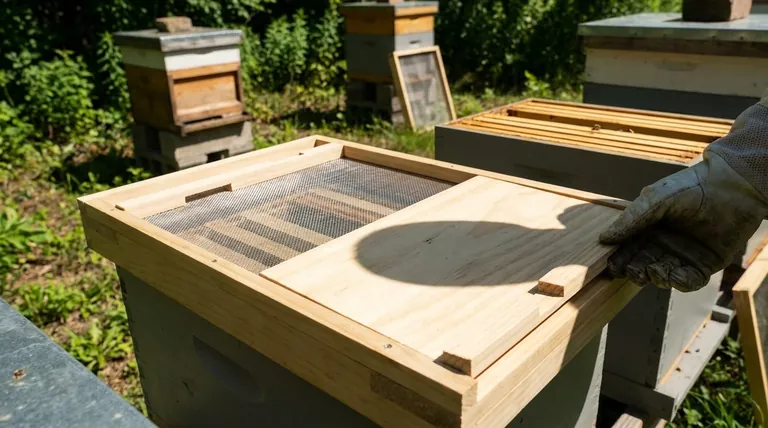At its core, the versatility of a screened bottom board stems from its 3-in-1 design that combines a hive floor, a passive ventilation system, and a pest monitoring tool. Its key feature is a removable solid insert that slides in or out, allowing a beekeeper to instantly switch between a solid floor and a screened, open-air floor to adapt to changing hive needs.
A screened bottom board is not merely the floor of your hive; it is an active management tool that gives you dynamic control over ventilation, pest management, and colony diagnostics throughout the year.

The Three Roles of a Screened Bottom Board
A standard solid bottom board serves one purpose: to be the floor of the hive. A screened bottom board transforms this static component into a multi-function device critical for modern hive management.
1. As a Ventilation System
The primary benefit of the screen is passive ventilation. During hot summer months, heat can build up inside a crowded hive, forcing bees to expend energy fanning to cool the brood nest.
By removing the solid insert, you create a large, screened opening. This allows hot air to escape and fresh air to circulate, reducing the cooling burden on the colony and minimizing the chances of bees "bearding" on the outside of the hive.
2. As a Pest Management Tool
The varroa mite is the single greatest threat to honey bee colonies. A screened bottom board is a crucial, non-chemical part of an Integrated Pest Management (IPM) strategy.
When mites lose their grip or are groomed off by bees, they fall downwards. With a solid floor, they can simply climb back onto another bee. With a screen, a significant portion of these mites fall completely out of the hive, breaking their life cycle and reducing the overall mite population.
3. As a Diagnostic Device
The removable insert, often called a "sticky board" when coated with oil or shortening, is an invaluable monitoring tool. Sliding it in for a 24-48 hour period allows you to "read" what is happening inside the hive.
By counting the varroa mites that have fallen onto the board, you can accurately estimate the infestation level of your colony. This data empowers you to decide if and when a treatment is necessary, preventing you from treating blindly. You can also analyze debris like wax cappings and pollen to gauge brood rearing activity.
Understanding the Trade-offs
While incredibly useful, a screened bottom board is not a "set it and forget it" solution. Its effectiveness depends on understanding its limitations.
The Risk of Over-Ventilation
In cold climates, leaving the screen open during winter can be detrimental. It creates a draft that makes it harder for the bees to maintain the life-sustaining temperature of their winter cluster, forcing them to consume more honey stores.
For this reason, the solid insert is almost always installed during the cold winter months to seal the bottom of the hive and conserve heat.
The Need for Proper Entrance Management
The bottom board serves as the hive entrance. While the screen itself is secure, the entrance must be managed. Using an entrance reducer is still critical, especially for new or weak colonies, to help them defend against robbing from other bees or pests.
Adapting Your Board for Peak Hive Health
Your screened bottom board should be managed differently depending on the season and your immediate goal.
- If your primary focus is summer heat relief: Remove the solid insert completely to provide maximum airflow and reduce stress on the colony.
- If your primary focus is varroa mite monitoring: Insert the "sticky board" for 24-72 hours to perform a mite count, then remove it.
- If your primary focus is winter survival: Install the solid insert to close the screen, conserve heat, and prevent cold drafts from disturbing the winter cluster.
Properly used, the screened bottom board gives you a powerful window into the health and needs of your colony.
Summary Table:
| Function | Key Benefit | How It Works |
|---|---|---|
| Ventilation | Reduces heat stress | Screen allows hot air to escape, lessens fanning burden on bees. |
| Pest Management | Non-chemical varroa control | Mites fall through screen, breaking their life cycle. |
| Diagnostics | Monitors hive health | Sticky board catches mites/debris for accurate infestation counts. |
Upgrade your apiary's efficiency and bee health with HONESTBEE.
As a trusted supplier for commercial apiaries and beekeeping equipment distributors, we provide the durable, high-quality screened bottom boards and other essential equipment your operation needs for superior hive management.
Let our wholesale-focused expertise help you build stronger, more productive colonies.
Contact HONESTBEE today to discuss your needs and request a quote!
Visual Guide

Related Products
- Langstroth Screen Bottom Board for Beekeeping Wholesale
- Australian Pine Wood Langstroth Screen Bottom Board for Wholesale
- HONESTBEE Wooden Bee Escape Board with Triangle Mesh Design for Beekeeping
- Boardman Entrance Bee Feeder Durable Galvanized Steel and Wood Construction for Beekeeping
- HONESTBEE Professional Frame Wiring Board and Jig
People Also Ask
- How does a screened bottom board assist with temperature control and pest management? A Key Tool for Modern Beekeeping
- What are the benefits of using a screened bottom board for beehives? Improve Ventilation & Mite Control
- What are the main benefits of using a Screened Bottom Board in beekeeping? Enhance Hive Health & Productivity
- What are some considerations when choosing between solid and screened bottom boards? Optimize Hive Health & Pest Control
- What are the benefits of a screened bottom board? Boost Hive Health & Control Varroa Mites



















